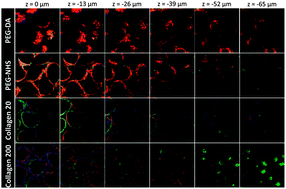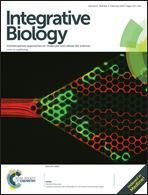Phenotypic regulation of liver cells in a biofunctionalized three-dimensional hydrogel platform†
Abstract
Loss of function is a major challenge for hepatocytes that are cultured on two-dimensional (2D) cell culture platforms. Biofunctionalized three-dimensional (3D) scaffolds produced by microfabrication strategies can overcome these limitations by presenting vital environmental cues, strong mechanical properties, and three-dimensional geometry to enable high-fidelity liver tissue engineering. Herein, we report the detailed investigation of hepatocarcinoma (Huh 7.5) cellular behavior in a collagen-functionalized microsphere-templated poly(ethylene glycol) (PEG) hydrogel scaffold which promotes 3D hepatic sheet morphology. Collagen conjugation led to improved liver-specific functions, including albumin production and cytochrome P450 (CYP450) activity. Importantly, the gene expression of numerous cell-adhesion markers was enhanced along with stimulated innate hepatocyte fibronectin production. Taken together, the findings reveal a close connection between hepatic cell morphology and gene expression, offering evidence that surface-coated collagen in the 3D hydrogel platform triggers the upregulation of hepatocyte-specific transcription factors and the secretion of liver metabolic markers.


 Please wait while we load your content...
Please wait while we load your content...